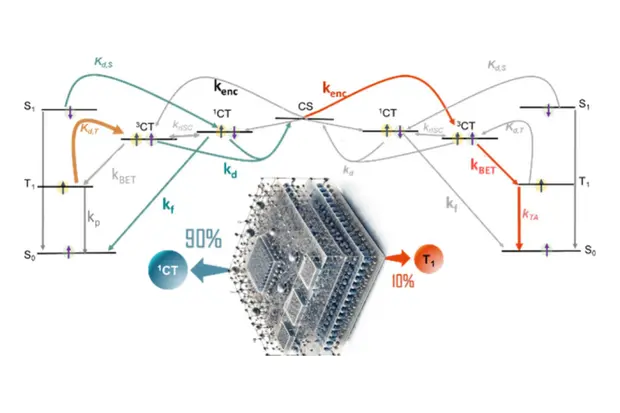Disordered Semiconductors
The semiconductor industry has long been dominated by inorganic materials, but organic semiconductors offer new possibilities with their customizable electronic properties, mechanical flexibility, and environmentally friendly nature. These materials enable applications beyond the reach of traditional semiconductors, paving the way for sustainable electronics and spintronics. However, major challenges in organic semiconductor technologies include their inherent disorder and stability, both of which constrain performance and scalability. Addressing these issues requires an interdisciplinary approach that combines advanced fabrication techniques with novel characterization methods.
This CReA focuses on bringing order to disordered organic semiconductors by leveraging epitaxial growth technique. Additionally, it will use advanced spectroscopic tools to gain deeper understanding into the remaining unresolved questions. Key objectives include:
- Developing epitaxial organic photoactive layers using molecular beam epitaxy (MBE) to control disorder-related limitations in organic solar cells.
- Device physics of organic and hybrid solar cells.
- Fundamental electrical, spectroscopic and structural studies of molecular electronic materials with numerical modelling and device studies, with the aim of optimizing the performance and stability of single junction and tandem solar cells based on molecular and hybrid materials.
- Probing dark spin states, to understand spin-transport, spin-generation and spin-detection at room temperature to explore their potential for spintronics.
- Advancing experimental and modeling tools to clarify the fundamental structure-property relationships in organic semiconductors.
We are interested in advancing scientific understanding of the charge and spin transport as well as the photophysics of organic semiconductors and low-temperature processible hybrid organic-inorganic semiconductors. By bridging the gap between organic and inorganic semiconductor research, this work opens new possibilities for high-performance optoelectronic and spintronic devices. The ability to fabricate highly ordered organic semiconductors could lead to more efficient solar cells, and novel hybrid materials. Furthermore, gaining insights into spin properties at room temperature brings us closer to practical spintronic applications. Ultimately, this research contributes to the development of transformative, sustainable technologies that address global challenges in energy (mitigation potential of solar photovoltaic technology) and information processing.
Scientific Highlights
Rethinking Energy Loss in Organic Solar Cells
A new study overturns a key assumption in solar cell design: that triplet excitons are always bad news. Researchers have discovered that, under the right conditions, these excited states don’t necessarily lead to large voltage losses—offering fresh insight into how organic solar cells can be made even more efficient. More…
Selected Publications
2025
- Understanding the fill-factor limit of organic solar cells
Authors: Huotian Zhang, Jun Yuan, Tong Wang, Nurlan Tokmoldin, Rokas Jasiunas, Yiting Liu, Manasi Pranav, Yuxuan Li, Xiaolei Zhang, Vidmantas Gulbinas, Safa Shoaee, Yingping Zou, Veaceslav Coropceanu, Artem A Bakulin, Dieter Neher, Thomas Kirchartz, Feng Gao
Source: arXiv preprint arXiv.2507.22217
DOI: https://doi.org/10.48550/arXiv.2507.22217
- Discerning Performance Bottlenecks of State‐of‐the‐Art Narrow Bandgap Organic Solar Cells
Authors: Atul Shukla, Manasi Pranav, Guorui He, J Terence Blaskovits, Davide Mascione, Yonglin Cao, Yufei Gong, Drew B Riley, Julian A Steele, Eduardo Solano, Alexander Ehm, Mohammad Saeed Shadabroo, Ardalan Armin, Safa Shoaee, Dietrich RT Zahn, Yongfang Li, Lei Meng, Felix Lang, Denis Andrienko, Dieter Neher
Source: Advanced Energy Materials, 2502398
DOI: https://doi.org/10.1002/aenm.202502398
- Triplet Excitons Reconcile Charge Generation and Recombination in Low-Offset Organic Solar Cells: Efficiency Limits from a 5-State Model
Authors: JL Langentepe-Kong, M Pranav, S Shoaee, D Neher
Source: arXiv preprint arXiv:2505.15603
DOI: https://doi.org/10.48550/arXiv.2505.15603
- Toward understanding the built-in field in perovskite solar cells through layer-by-layer surface photovoltage measurements
Authors: Emilio Gutierrez-Partida, Marin Rusu, Fengshuo Zu, Meysam Raoufi, Jonas Diekmann, Nurlan Tokmoldin, Jonathan Warby, Dorothee Menzel, Felix Lang, Sahil Shah, Safa Shoaee, Lars Korte, Thomas Unold, Norbert Koch, Thomas Kirchartz, Dieter Neher, Martin Stolterfoht
Source: ACS Appl. Mater. Interfaces 2025, 17, 7, 11176–11186
DOI: https://doi.org/10.1021/acsami.4c14194
2024
- Contemporary Impedance Analyses of Archetypical PM6: Y6 Bulk‐Heterojunction Blend
Authors: N. Tokmoldin, C. Deibel, D. Neher, S. Shoaee
Source: Adv. Energy Mater., 14, 2401130 (2024)
DOI: 10.1002/aenm.202401130
- Key factors behind the superior performance of polymer-based NFA blends
Authors: E. Sağlamkaya, M. S. Shadabroo, N. Tokmoldin, T. M. Melody, B. Sun, O. Alqahtani, A. Patterson, B. A. Collins, D. Neher, S. Shoaee
Source: Mater. Horiz., 11, 5304-5312 (2024)
DOI: 10.1039/D4MH00747F
2023
